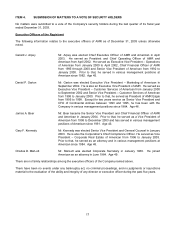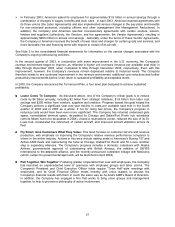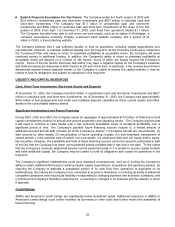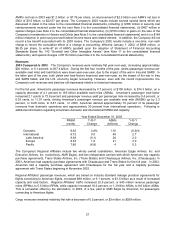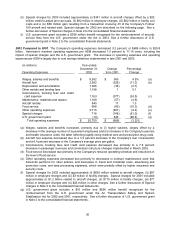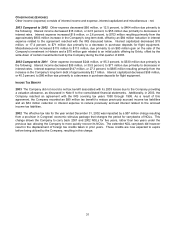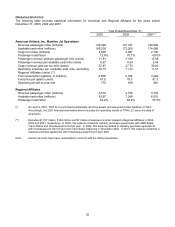American Airlines 2003 Annual Report Download - page 24
Download and view the complete annual report
Please find page 24 of the 2003 American Airlines annual report below. You can navigate through the pages in the report by either clicking on the pages listed below, or by using the keyword search tool below to find specific information within the annual report.
22
•
••
• Build A Financial Foundation For Our Future: The Company ended the fourth quarter of 2003 with
$2.6 billion in unrestricted cash and short-term investments and $527 million in restricted cash and
short-term investments. The Company had $1.3 billion in unrestricted cash and short-term
investments and $550 million in restricted cash and short-term investments at the close of the first
quarter of 2003. From April 1 to December 31, 2003, cash flows from operations totaled $1.1 billion.
The Company has also been able to sell some non-core assets, such as its stakes in Worldspan, a
computer reservations company; Hotwire, a discount travel website company; and a portion of its
stake in Orbitz, a travel planning website.
The Company believes that it has sufficient liquidity to fund its operations, including capital expenditures and
commitments. However, to maintain sufficient liquidity over the long-term as the Company continues to implement
the Turnaround Plan and seeks to return to sustained profitability at acceptable levels, the Company will need
continued access to additional funding. In addition, the Company’s ability to return to sustained profitability at
acceptable levels will depend on a number of risk factors, many of which are largely beyond the Company’s
control. Some of the risk factors that have had and/or may have a negative impact on the Company’s business
and financial results are discussed in Risk Factors at the end of this Item. In particular, if the revenue environment
deteriorates beyond normal seasonal trends, or the Company is unable to access the capital markets, it may be
unable to fund its obligations and sustain its operations in the long-term.
LIQUIDITY AND CAPITAL RESOURCES
Cash, Short-Term Investments, Restricted Assets and Deposits
At December 31, 2003, the Company had $2.6 billion in unrestricted cash and short-term investments and $527
million in restricted cash and short-term investments. As of December 31, 2003, the Company had approximately
$166 million in fuel prepayments and credit card holdback deposits classified as Other current assets and Other
assets in the consolidated balance sheets.
Significant Indebtedness and Future Financing
During 2001, 2002 and 2003, the Company raised an aggregate of approximately $10.0 billion of financing to fund
capital commitments (mainly for aircraft and ground properties) and operating losses. The Company expects that
it will need to continue to raise capital until it has achieved acceptable levels of sustained profitability over a
significant period of time. The Company’s possible future financing sources include: (i) a limited amount of
additional secured aircraft debt (virtually all of the Company’s Section 1110-eligible aircraft are encumbered), (ii)
debt secured by other assets, (iii) securitization of future operating receipts, (iv) sale-leaseback transactions of
owned aircraft, (v) the potential sale of certain non-core assets, (vi) unsecured debt and (vii) equity and/or equity-
like securities. However, the availability and level of these financing sources cannot be assured, particularly in light
of the fact that the Company has fewer unencumbered assets available than it has had in the past. To the extent
that the Company’s revenues deteriorate beyond normal seasonal trends or it is unable to access capital markets
and raise additional capital, the Company may be unable to fund its obligations and sustain its operations in the
long-term.
The Company’s significant indebtedness could have important consequences, such as (i) limiting the Company’s
ability to obtain additional financing for working capital, capital expenditures, acquisitions and general purposes, (ii)
requiring the Company to dedicate a substantial portion of its cash flow from operations to payments on its
indebtedness, (iii) making the Company more vulnerable to economic downturns, (iv) limiting its ability to withstand
competitive pressures and reducing its flexibility in responding to changing business and economic conditions, and
(v) limiting the Company’s flexibility in planning for, or reacting to, changes in its business and the industry in which
it operates.
Credit Ratings
AMR’s and American’s credit ratings are significantly below investment grade. Additional reductions in AMR's or
American's credit ratings could further increase its borrowing or other costs and further restrict the availability of
future financing.







